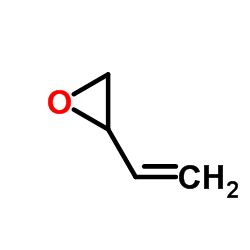3,4-Epoxy-1-butene, a reactive metabolite of 1,3-butadiene, induces somatic mutations in Xpc-null mice.
J K Wickliffe, L A Galbert, M M Ammenheuser, S M Herring, J Xie, O E Masters, E C Friedberg, R S Lloyd, J B Ward
Index: Environ. Mol. Mutagen. 47(1) , 67-70, (2006)
Full Text: HTML
Abstract
Xpc-null (Xpc-/-) mice, deficient in the global genome repair subpathway of nucleotide excision repair (NER-GGR), were exposed by intraperitoneal (i.p.) injection to a 300 mg/kg mutagenic dose of 3,4-epoxy-1-butene (EB), to investigate NER's potential role in repairing butadiene (BD) epoxide DNA lesions. Mutagenic sensitivity was assessed using the Hprt assay. Xpc-/- mice were significantly more sensitive to EB exposure, exhibiting an average 2.8-fold increase in Hprt mutant frequency (MF) relative to those of exposed Xpc+/+ (wild-type) mice. As a positive control for NER-GGR, additional mice were exposed by i.p. injection to a 150 mg/kg mutagenic dose of benzo[a]pyrene (B[a]P). The Xpc-/- mice had MFs 2.9-fold higher than those of exposed Xpc+/+ mice. These results suggest that NER-GGR plays a role in recognizing and repairing some of the DNA adducts formed following in vivo exposure to EB. Additional research is needed to examine the response of Xpc-/- mice, as well as other NER-deficient strains, to inhaled BD. Furthermore, it is likely that alternative DNA repair pathways also are involved in restoring genomic integrity compromised by BD-epoxide DNA damage. Collaborative studies are currently underway to address these critical issues.2005 Wiley-Liss, Inc.
Related Compounds
| Structure | Name/CAS No. | Molecular Formula | Articles |
|---|---|---|---|
 |
2-Vinyloxirane
CAS:930-22-3 |
C4H6O |
|
In vivo doses of butadiene epoxides as estimated from in vit...
2014-12-15 [Toxicol. Appl. Pharmacol. 281(3) , 276-84, (2014)] |
|
Mutagenicity of stereochemical configurations of 1,2-epoxybu...
2007-03-20 [Chem. Biol. Interact. 166(1-3) , 207-18, (2007)] |
|
Dose responses for DNA adduct formation in tissues of rats a...
2004-03-15 [Chem. Biol. Interact. 147(2) , 195-211, (2004)] |
|
Identification of covalent modifications in P450 2E1 by 1,2-...
2007-03-20 [Chem. Biol. Interact. 166(1-3) , 170-5, (2007)] |
|
Reactive metabolites of 1,3-butadiene: DNA and hemoglobin ad...
2001-01-01 [Adv. Exp. Med. Biol. 500 , 93-103, (2001)] |